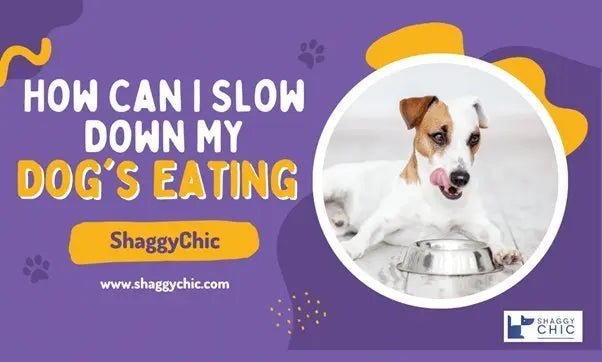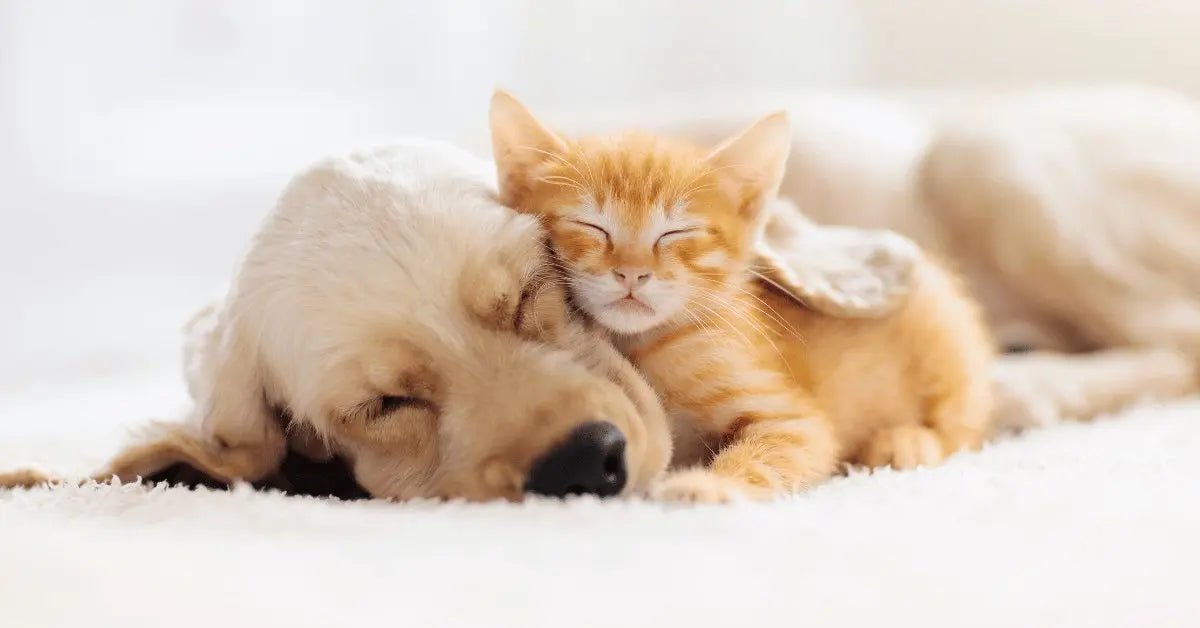
How Can I
How Can I Slow Down My Dog's Eating: Prevent Bloat & Improve Digestion
Is your dog the Usain Bolt of mealtimes? Does their bowl vanish in under a minute? If so, you're not alone. Gobble-and-go eating is common, but it's not good for your pup's health. It can lead to bloat (a serious issue) and messy digestion.
Don't worry, help is here. We'll show you how to turn your furry speed-eater into a more mindful muncher. Get ready to explore:
- Why fast-eating is a big no-no for pups
- Easy tricks to slow your dog's roll (no fancy gadgets needed)
- The best slow-feeding gear on the market
- When a vet visit might be the answer
Why Fast-Eating Is a Big No-No for Pups
Think of your dog's stomach like a balloon. Stuff too much food in too quickly, and it's a recipe for disaster. Here's what can happen when your pup scarfs down their dinner:
- Choking: Big bites mean big trouble. Dogs that don't chew properly risk choking on pieces that are too large. Yikes!
- The not-so-fun burps: Inhaling food means inhaling air, leading to uncomfortable gas and those doggy burps you could do without.
- Bloat – a serious threat: This is the biggie. Bloat (GDV) occurs when the stomach fills with gas or food and twists on itself. It's life-threatening and needs immediate vet attention.
- Upchuck central: Feeling full too quickly can trigger the gag reflex. While not dangerous, it's messy and means your dog misses out on valuable nutrition.
Fast eating is not just about health risks. It's stealing the simple joy of mealtime from your furry friend.
Easy Tricks to Slow Your Dog's Roll

Ready to put the brakes on your dog's dinner dash? These simple tricks cost next to nothing and deliver big results:
- Hand feed: Take total control. Feed your dog small handfuls of food. This is time-consuming but great for training and bonding.
- Muffin tin magic: Turn mealtime into a treasure hunt. Spread kibble across a muffin tin – your dog must work to sniff out every bite.
- Floating kibble: Fill a large, shallow dish with water and add kibble. Your pup has to fish for their dinner – it's both a game and a slowdown tactic.
- Turn mealtime into training time: Instead of a bowl feeding frenzy, use kibble as training rewards. This doubles as mental stimulation (a tired dog is less likely to inhale food.)
- Break up the bowl: Ditch the standard food dish. Scatter kibble around the kitchen floor (on an easy-to-clean surface, of course). This forces your dog to slow down and search for each bite.
- DIY puzzle feeder: Got a tennis ball? Place it in your dog's bowl along with their kibble. They'll have to nudge the ball around to access the food – a fun challenge.
- Snuffle mat fun: Invest in a snuffle mat, a fabric mat with pockets where you hide kibble. Your dog will have a blast sniffing out their dinner, mimicking natural foraging behavior.
- Food cube playtime: Freeze some kibble in a Kong toy or ice cube tray. Licking the frozen treat will take your pup longer to consume their meal, keeping them occupied and cool on hot days.
With these easy tricks, you can transform your dog's mealtime from a race against the clock into a fun and enriching experience. Remember, a slower eating pace not only improves your pup's digestion and reduces health risks but also strengthens your bond through positive reinforcement.
The Best Slow-feeding Gear on the Market
Sometimes, DIY tricks aren't enough – that's where a dedicated slow feeder comes in. Here's a quick look at the top contenders:
- Puzzle feeders: These maze-like bowls or toys make your dog work for their food. They come in a variety of difficulties, from beginner to brain-buster. Look for sturdy, dishwasher-safe options.
- Interactive food puzzles: Think of these as the next level up. Treat-dispensing toys with multiple compartments or moving parts keep your pup engaged and entertained for longer.
- Elevated slow feeder bowls: These bowls feature raised ridges or nubs that force your dog to eat around the obstacles. Opt for non-slip bases and a size appropriate for your dog's breed.
Pro tip: Always supervise your dog with a new slow feeder. You want to make sure they don't get frustrated or try to destroy the feeder in their haste for food.
Before you invest, consider your dog's personality and eating style. A super-smart pup might need a trickier puzzle, while a timid dog might prefer a simple bowl design.
When a Vet Visit Might Be the Answer
While slowing down your dog's eating has tons of benefits, sometimes there's more to the story. If you've tried various methods and your pup still gobbles food at warp speed, it's time to chat with your vet. Here's why:
- Underlying medical issues: Speedy eating can be a symptom of health conditions like parasites, digestive problems, or even anxiety. Your vet can help rule these out.
- Extreme hunger: Always feeling ravenous, even after a meal, could signal a problem. This could range from worms to more serious metabolic issues.
- Behavioral concerns: Some dogs gulp their food due to resource guarding or past experiences with food insecurity. Your vet might recommend a behavioral specialist to help.
Remember, it's not about weakness! You're a great pet owner for wanting the best for your furry friend. Seeking professional help gets to the root of the problem and lets you develop a customized solution for a happier, healthier pup.
Final Thoughts: Time to put those brakes on!
You've got the tools to help your furry friend become a savorer, not a scarfer. Say goodbye to upset tummies and messy mealtimes, and hello to a healthier, happier pup.
-
Let's recap those key takeaways:
- Fast eating isn't just annoying – it's a potential health risk.
- Simple tricks like muffin tins and hand-feeding can make a big difference.
- Consider a vet visit if your dog's speed-eating persists.
- Slowing down mealtime can also be fun and enriching for your dog.
Speaking of fun, does your pup need some new gear to celebrate their slower eating habits? ShaggyChic has everything to spoil your best friend, from personalized bowls to stylish snuffle mats. Plus, our awesome spring collection is out now! Treat your pup (and yourself) to some well-deserved goodies. After all, a happy dog means a happy home.
FAQs
My dog eats too fast and doesn't chew. Is this a problem?
Absolutely. Eating too fast poses several risks for dogs. These include choking, gagging, vomiting, uncomfortable gas, and even the life-threatening condition bloat (GDV). Slowing down your dog's eating habits is crucial for their health and well-being.
What are the symptoms of a dog eating too fast?
Here's what to watch for:
- Gulping food without chewing
- Audible gagging or choking sounds
- Vomiting shortly after eating
- Excessive gas and burping
- Whining or pacing immediately after eating (indicating discomfort)
How can I slow down my dog eating wet food?
While dry kibble is easier to manipulate, here are ways to slow down wet food consumption:
- Spread it out: Use a lick mat or a wide, shallow dish to spread the wet food into a thin layer.
- Mix with kibble: Add a small amount of kibble to the wet food, forcing your dog to slow down and pick out the pieces.
- Freeze it: Freeze wet food in a Kong or ice cube tray, making it a longer-lasting, puzzle-like treat.
My dog eats too fast and throws up. What should I do?
First, try the slow-feeding tactics we discussed. If vomiting persists or worsens, consult your veterinarian. This could indicate an underlying digestive or behavioral issue that needs addressing.
My dog ate too fast and is now bloated. Help!
Bloat (GDV) is a serious emergency. If your dog's abdomen appears swollen or hard, and they are retching without vomiting, seek immediate veterinary care. Time is of the essence in cases of bloat.




